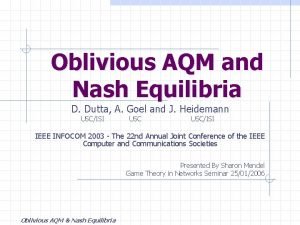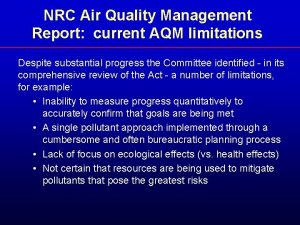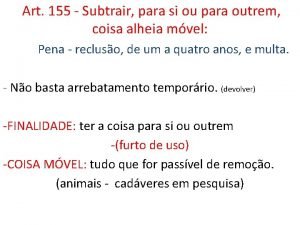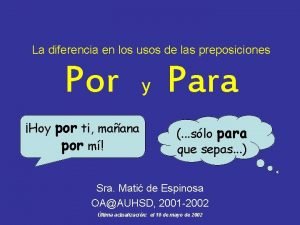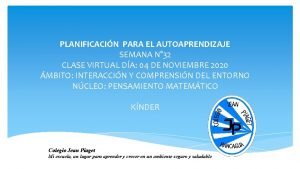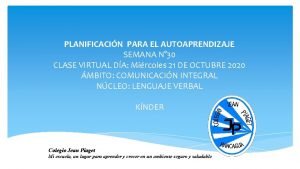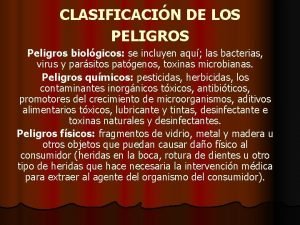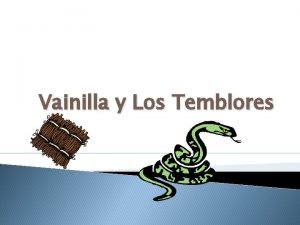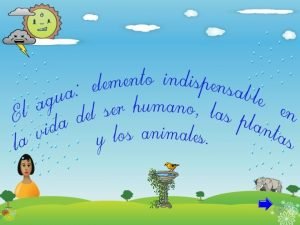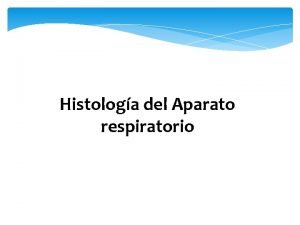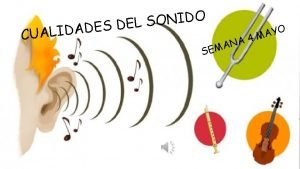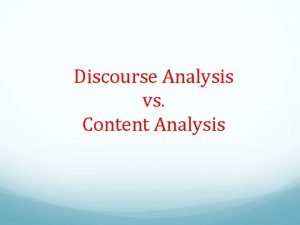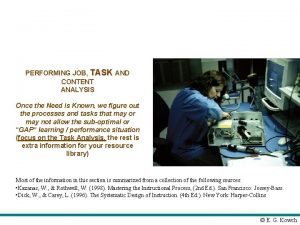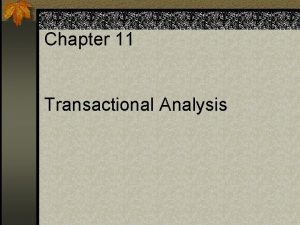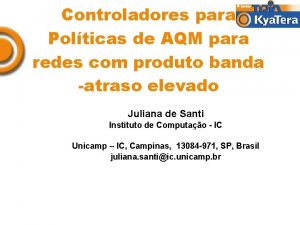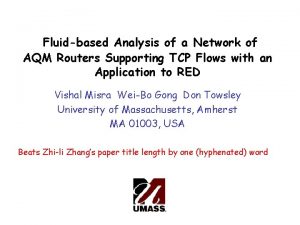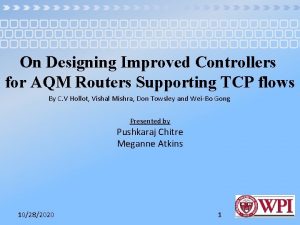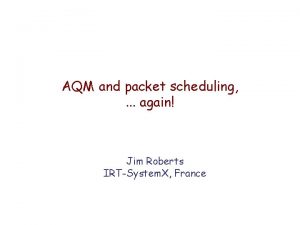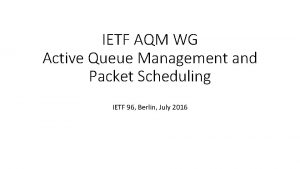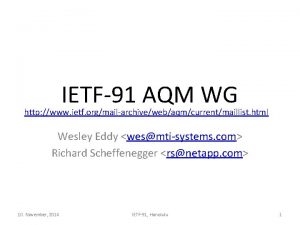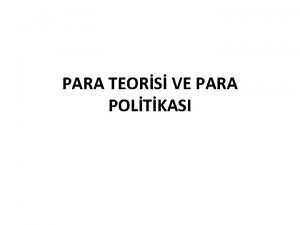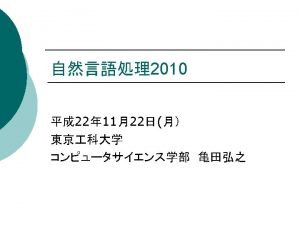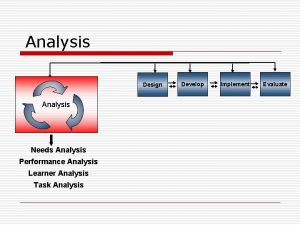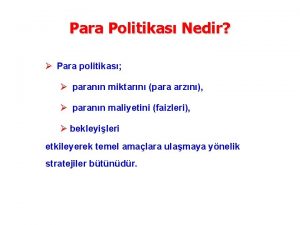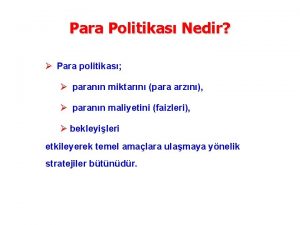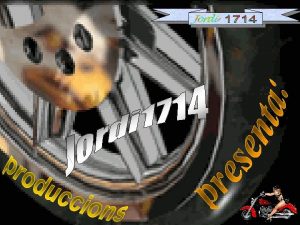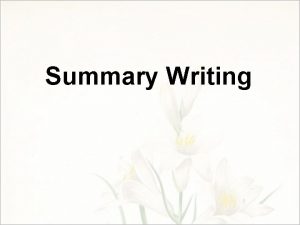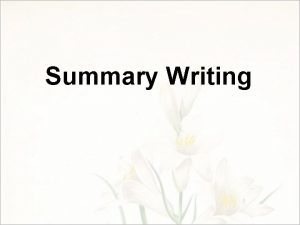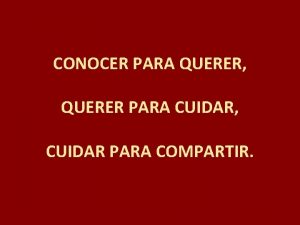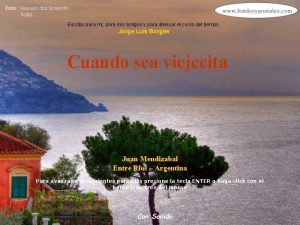Analysis of AQM v 6 0 para 6


























- Slides: 26

Analysis of AQM v 6. 0 (para 6 d) Performance GFSv 16 -NACC-CMAQv 5. 3. 1 NATIONAL WEATHER SERVICE Jeff Mc. Queen, Fanglin Yang, Ivanka Stajner, Jianping Huang, Ho-Chun Huang, Li Pan, Ed Strobach, Binyu Yang, Partha Bhatarchjee, Perry Shafran NWS/NCEP/EMC Rick Saylor, Barry Baker, Youhua Tang, Patrick Campbell, Daniel Tong, NOAA/ARL March 31 , 2021 NATIONAL WEATHER SERVICE Building a Weather-Ready Nation // 1

National Air Quality Forecast Capability • • Improving the basis for air quality alerts Providing air quality information for people at risk AQM V 6. 0: Proposed July 2021 ● ● ● ● ● 72 hour predictions GFSv 16 – CMAQ V 5. 3. 1 GBBEPx 0. 1 deg smoke emissions NEI 2016 Inline emissions, deposition Updated Fengsha dust scheme w/ improved soil definitions Daily updated real-time Greenness vegetation fraction (GVF) Climatological Leaf Area Index (LAI) GEFS-Aerosols 25 km full lateral boundary conditions 2007: ozone/ hys. smoke 2012: Hysplit dust 2016: + PM 2. 5 2018: O 3/PM Bias correct. 2004: ozone 2005: ozone 2009: Hy smoke(ak) 2010: Hy smoke(hi) 2010: ozone(ak/hi) 2016: PM 2. 5 (ak/hi)

Issues with use of NEI 2017 ● PARA 6 C: NEI 2017 ● PARA 6 D: NEI 2016 PARA 6 C: old experimental run • • • Latest standard (Apr 2020/Jan. 2021 release) Led to enhanced underprediction of ozone over West and around wild fires Missed o 3 exceedences over Western U. S. PARA 6 D: New retrospective PARA 6 d: Aug 2020, Jan 2021 • Same as 6 c except for use of NEI 2016 • Adjusted from NEI 2014 using old SMOKE processor

GEFSv 12 -Aerosol member One additional member of GEFSv 12 for aerosols Implemented Sept. 23, 2020 GEFS meteorology (based on GFSv 15) at C 384 (~25 km), 64 levels, to 120 hrs, 4 x/day • Inline aerosol representation based on GOCART (GSD-Chem) • Sulfate, Organic Carbon, Black Carbon, Dust, Sea Salt • Emissions: CEDS-2014 (SO 2, PSO 4, POC, PEC), GBBEPx biomass burning, FENGSHA dust, GEOS-5 sea salt, marine DMS • Initial conditions: cycled for aerosols, but from GFSv 15 analysis for meteorology • Smoke plume rise: Wind shear dependent 1 -d cloud model to simulate tilt of plume. Fire Radiative Power is used to calculate convective heat flux and determine injection height Conservative tracer transport and wet scavenging are included in Simplified Arakawa-Schubert (SAS) scheme. Fluxes are calculated positive definite. Scavenging coefficient is α=0. 2 for all aerosol species. Li Pan, EMC; GSL; ARL; CSL • • • CEDS-2014 SO 2 emissions

CMAQ Model runs Model Fire location information Fire smoke Emissions Fire Duration Fcst length Comments PROD NAM-CMAQ V 5. 0. 2 24 h old NESDIS Haz Mapping Sys (HMS) fire points USFS Blue. Sky Full during 24 h preanalysis 75% reduction during forecast 48 h Since 12/18/2018 EXP PARA 6 D GFSv 16 CMAQ v 5. 3. 1 Ho-Chun Huang 24 h old VIIRS/MODIS Fire Radiative Power (FRP) 100% of GBBEPx “ “, day 2 fire emissions off over East (simplified ag fire treatment) 72 h *Weekly GVF * Climo LAI *NEI 2016 * NOx fire emissions Official evaluation web page: https: //www. emc. ncep. noaa. gov/users/meg/cmaqv 6/ - August 2 - August 31, 2020 - Jan 1. - January 31, 2021 (Sept, Feb also becoming available) 8

AQM v 6. 0 Evaluation Request Evaluation Letter : March 2, 2021 March 30, 2021 • • • Link to evaluation form Link to verification statistic web site https: //www. emc. ncep. noaa. gov/users/meg/cmaqv 6/ Link to retrospective (Aug/Jan) and near real-time run graphical maps Return Evaluations : April 2, 2021 April 6, 2021 • • • Impression of upgrade impacts on AQM forecasts for your area Model performance for events impacted by wild fires Skillfulness if any of 72 hour forecasts EMC Evaluation summary webinar: April 6, 2021 Director’s briefing: April 9, 2021 8: 15 AM EDT

NATIONAL OCEANIC AND ATMOSPHERIC ADMINISTRATION GFSv 16: Possible impacts on AQ • Reduce the low-level cold bias seen in GFSv 15 during the cool season • Improve handling of inversions in the planetary boundary layer (PBL) • Reduce near-surface temperature biases in all seasons • Improve forecasts of the upper atmosphere

August, 2020: 2 -m Temperature EAST: GFS agrees better with observations WEST: GFS too warm at all times

August, 2020: 2 -m Dewpoint • NAM does much better at predicting low-level moisture

August, 2020: PBL Height • • • WEST: More aggressive PBL growth during the day for GFS-CMAQ. This is inline with increased 2 -m temps, drier dew points, and more momentum mixing toward the surface EAST: PBL heights are comparable between configurations during the day with a noted lag in prod. PBL heights are shallower during the evening for experimental run. It’s not uncommon to see a more mixed PBL for GFS-CMAQ relative to NAM-CMAQ during the day.

August, 2020: Surface Ozone Ed Strobach, EMC Ozone improved for para 6 d over both regions • Results in remarkable agreement with observations out EAST while some under-predictions remain out WEST • Use of NEI 2016 (paa 6 d) improves performance further Bias correction Predictions agree best with observations for both regions

August, 2020: 8 h max O 3 Critical Success Index • • Use of NEI 2016 improved performance for all thresholds (PARA 6 D) NEI 2016 run bias correction results lag other bias corrected results out west. NED) Ed Strobach, EMC

Valid: August 18 2020 Ozone episode Exp FV 3 GFS-CMAQ vs Prod NAM-CMAQ EXPERIMENTAL OPERATIONAL Day 1 Raw NATIONAL WEATHER SERVICE Day 2 Raw Bias Corrected Day 1 Daily maximum of 8 h ozone (ppb). Building a Weather-Ready Nation // 18 Observed values are in circles.

Valid : August 22 2020 Ozone episode Exp Bias Corrected FV 3 GFS-CMAQ vs Prod NAM-CMAQ EXPERIMENTAL OPERATIONAL Day 1 NATIONAL WEATHER SERVICE Day 3 Daily maximum of 8 h ozone (ppb) valid on August 22, 2020. Observed values are in circles. Day 2 Building a Weather-Ready Nation // 19

Day 3 8 h daily max Ozone forecasts Experimental Bias Corrected FV 3 GFS-CMAQ PARA 6 D Valid August 10 NATIONAL WEATHER SERVICE Valid August 18 Valid August 26 Daily maximum of 8 h ozone. Building (ppb). a Weather-Ready Nation // 20

August, 2020: Surface PM 2. 5 • • . PM 2. 5 uniformly decreased for experimental predictions over both regions • Results in better agreement with observations out EAST while large under-predictions remain out WEST Bias correction components do pretty well except with some obvious departures out WEST.

August, 2020: Surface PM 2. 5 • • Use of NEI 2016 did not improve PM 2. 5 event predictions overall in August Experimental model predictions degrade performance compared to operational run • Bias. NEI 2016 run bias correction degraded ? NED)

Valid : August 22 2020 24 hr avg PM 2. 5 Exp FV 3 GFS-CMAQ (6 d) vs Prod NAM-CMAQ Day 1 RAW NATIONAL WEATHER SERVICE Day 1 Bias Corr Day 1 Difference EXP-OPR Bias Corrected Building a Weather-Ready Nation // 25

September 2020: hrly PM 2. 5 Northwest Coast PARA PROD Much less PM 2. 5 from fires in experimental run: fire emissions differences

January , 2021: PM 2. 5 WEST • • EAST: Improvement throughout the day for both experiments WEST: Night-time values of PM 2. 5 improved during the night while prod and parallel remain similar during the day

Jan 2021 : EAST Day 1 daily max (1 h)PM 2. 5 CSI Midwest EAST Southeast • • Experimental runs yield improved performance Use of NEI 2016 improves performance over SE

Jan 2021 : WEST Day 1 daily max (1 h)PM 2. 5 CSI WEST N. Plains South East Southwest • • Use of NEI 2016 improves performance over SW Exp. runs yield improved performance over N. Plains

Day 1 Raw vs Para 6 d 1 hr max PM 2. 5 VALID January 10, 2021 12 UTC run forecast EXP PROD

Summary ● + Ozone Predictions improved for all regions during August 2020 ■ Use of NEI 2016 emissions boosted results further ■ Day 3 forecasts yield similar skill to day 1 & 2 ● - PM 2. 5 Predictions behavior now yields an underprediction bias in summer ○ Underprediction and resulting skill degraded for both experiments over West especially ○ Bias correction skill is degraded further when NEI 2016 emissions used ● + January 2021 PM 2. 5 Predictions reduced error and improved skill especially at night near time of daily maximum ○ The long-standing overprediction error over East reduced significantly NATIONAL WEATHER SERVICE Building a Weather-Ready Nation // 31

Challenges ● NACC-CMAQ needed attention ○ GBBEPx source ○ Treatment of agricultural fires ○ Overmixing in PBL ○ plume rise too strong ○ scavenging too weak ● More timely output ○ Introduce restart capability after 48 hrs ○ Move to new Cray (WCOSS-2) by July 2022 NATIONAL WEATHER SERVICE Building a Weather-Ready Nation // 32

UFS Atmospheric Composition Modeling Goals 2024 -25 Capability Global GEFSv 13 (~25 km, 15 d) Regional inline LAM-Chem (3 km) Hazards dispersion HYSPLIT Anthro Emissions NEXUS/HEMCO (UFS) NEXUS/HEMCO (HSUP) Inverse modeling Biomass Burning Emissions Improved GBBEPx esp. over Africa Improved GBBEPx esp. for Rx/ag fires/impr. speciatiation (HSUP) On-demand local fires Data Assimilation VIIRS AOD (UFS) AOD, TROPOMI NO 2 (HSUP) Volcanic Ash Atmospheric Composition module Unified GOCART w/ nitrates (R 2 O) Online Optimized CMAQ: CB-VI, Aero 7 (HSUP) N/A Post-processing Improved AOD calculations (UFS) Machine learning for bias correction, chemistry (HSUP) Ensemble products(JTTI 19) Physical processes UFS Improved dust (albedo), NATIONAL WEATHER SERVICE Aerosol-wx interactions Improved dust, Trans. Coeff. Matrix Building a Weather-Ready Nation Aerosol-wx interactions src term calc. // 37
 Working aqm. is this future
Working aqm. is this future Aqm quality management
Aqm quality management Quien invento el antecesor del ebook
Quien invento el antecesor del ebook No nacimos para ser perfectos
No nacimos para ser perfectos Em uma obra para permitir o transporte de objetos para cima
Em uma obra para permitir o transporte de objetos para cima Consumir para viver ou viver para consumir
Consumir para viver ou viver para consumir Subtrair para si ou para outrem coisa alheia móvel
Subtrair para si ou para outrem coisa alheia móvel Trabaja para vivir no vivas para trabajar
Trabaja para vivir no vivas para trabajar Reglas para clases virtuales para niños camara encendida
Reglas para clases virtuales para niños camara encendida Reglas para clases virtuales para niños camara encendida
Reglas para clases virtuales para niños camara encendida Todo para todos nada para nosotros
Todo para todos nada para nosotros Modelo bidimensional para evaluar el riesgo para la salud
Modelo bidimensional para evaluar el riesgo para la salud Yo soy de mi amado y mi amado es mio hebreo
Yo soy de mi amado y mi amado es mio hebreo Subcutânea bisel para cima ou para baixo
Subcutânea bisel para cima ou para baixo Leyenda de los temblores
Leyenda de los temblores Frases para cuidar el agua para niños
Frases para cuidar el agua para niños Microcilios
Microcilios Brotan lagrimas de mis ojos este dia al recordarlos
Brotan lagrimas de mis ojos este dia al recordarlos Sonido agudo y grave
Sonido agudo y grave Structured analysis approach
Structured analysis approach Cuckoo malware analysis
Cuckoo malware analysis Content discourse analysis
Content discourse analysis Difference between contrastive analysis and error analysis
Difference between contrastive analysis and error analysis Types of intralingual errors
Types of intralingual errors What is fact analysis
What is fact analysis Content analysis and task analysis
Content analysis and task analysis Script analysis in transactional analysis
Script analysis in transactional analysis
